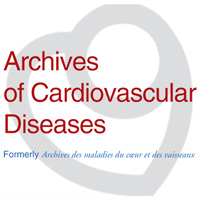Auteurs
Suc G, Zeitouni M, Procopi N, Guedeney P, Kerneis M, Barthelemy O, Le Feuvre C, Helft G, Rouanet S, Brugier D, Collet JP, Vicaut E, Montalescot G, Silvain J.
Abstract
Background
Systematic prescription of beta-blockers after myocardial infarction remains an open question in the era of revascularization, especially for patients with uncomplicated myocardial infarction.
Aims
To evaluate in a real-life registry the proportion of patients with uncomplicated myocardial infarction (preserved left ventricular ejection fraction and no cardiovascular event within the first 6 months), and to report their characteristics, outcomes and beta-blocker use.
Methods
We included 1887 consecutive patients with ST-segment elevation myocardial infarction from the prospective ePARIS registry. Patients were divided into three groups: the "uncomplicated myocardial infarction" group (n=1060), defined by a left ventricular ejection fraction ≥ 40% and a 6-month period free from cardiovascular events; the "complicated myocardial infarction" group (n=366), defined by a left ventricular ejection fraction ≥ 40% and a recurrent cardiovascular event in the first 6 months; and the "left ventricular dysfunction" group (n=461), defined by a left ventricular ejection fraction<40%.
Results
During a median follow-up of 2.7 years (interquartile range 1.0-4.9 years), the "uncomplicated myocardial infarction" group was at low mortality risk compared with the "complicated myocardial infarction" group (hazard ratio 0.38, 95% confidence interval 0.25-0.58; P<0.01) and the "left ventricular dysfunction" group (hazard ratio 0.22, 95% confidence interval 0.15-0.32; P<0.01). Beta-blockers were prescribed at discharge predominantly in the "uncomplicated myocardial infarction" group (93%) compared with 87% in the "complicated myocardial infarction" group and 81% in the "left ventricular dysfunction" group.
Conclusions
Beta-blockers are less prescribed in patients who may need them the most. The benefit of beta-blockers-largely prescribed in lower-risk patients-remains to be shown beyond the first 6 months for these patients with no left ventricular dysfunction and no recurrent events.



